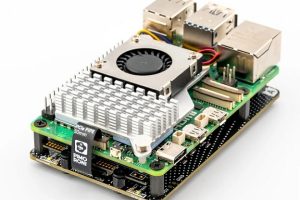There is an interface to enter a particular date and time and then you can see the moon change to that phase.
 Based on a Raspberry Pi Pico W and a Kitronik motorboard (right), it uses two DFRobot seven segment displays and all the coding is done in micropython.
Based on a Raspberry Pi Pico W and a Kitronik motorboard (right), it uses two DFRobot seven segment displays and all the coding is done in micropython.
With a full video promised soon, there’s not much extra info about this one, but the short video in the tweet below gives you the idea.
And it's done! My moon phase device.. enter a date, see the moon spin! Full video coming soon to @E14Community
Inside is a @Raspberry_Pi #picow @dfrobotcn 7 segment displays and a @Kitronik motorboard. All coded in #micropython pic.twitter.com/L1TDZ5XRUp— Lorraine Underwood (@LMcUnderwood) December 30, 2023
The creator is the maker and author Lorraine Underwood. Her book? “Save the World with Code: 20 Fun Projects for All Ages Using Raspberry Pi, micro:bit, and Circuit Playground Express” – you can check it out on Amazon.
Levitating Moon
For another lunar-related Gadget Master posts, check out the Ginko Moon Lamp, a light that is also a levitating Moon. It’s quite the desktop objet d’art.
Not only is it eye-catching and strangely arresting but I like the way it seems to represent a detailed map of the Moon’s surface.
We’re in the realm of magnetic forces – using a built-in magnet, the moon is suspended and floats in mid-air. And you can interact with the spinning to slow it down or speed it up.
See also: Picture of the Day: Scanning the 1960s moon with OCR
 Electronics Weekly Electronics Design & Components Tech News
Electronics Weekly Electronics Design & Components Tech News





